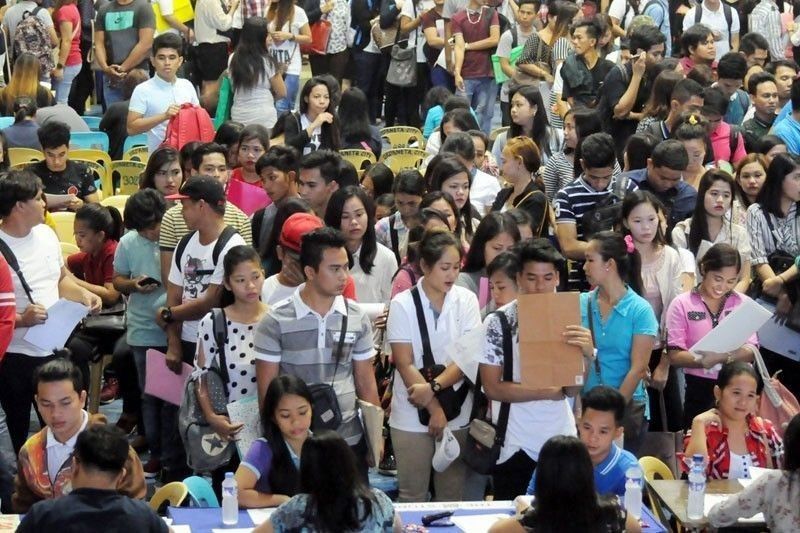Joblessness down in October, but largely because people quit looking for work

MANILA, Philippines (UPDATE 1:06 p.m., Dec. 3) — Fewer Filipinos went jobless and out of business in October, but this was largely a result of more people stopping job search for various reasons including going back to school or their old jobs getting killed by the ongoing digital shift.
The jobless rate, which is the proportion of unemployed people to the labor force, declined to 8.7% in October from 10% in July and a record-high of 17.7% in April, the Philippine Statistics Authority (PSA) reported on Thursday.
The latest data represented 3.8 million Filipinos out of jobs or livelihood in October, down from 4.6 million in July and 7.2 million in April when coronavirus lockdowns shut down enterprises. In normal times same period last year, only 2 million Filipinos suffered joblessness.
While at face value the labor market appeared to be gaining ground, the headline number omits Filipinos aged 15 years and above who, for getting discouraged or lack of job opportunities, have entirely dropped job hunting. That number of people is increasing, suggesting that while businesses have reopened, people are not entirely getting their jobs back.
The labor force participation rate, representing people actively looking for jobs, was at 58.7% in October, the second lowest since 2005. While start of schooling partly explained the dip, with students formerly searching job exiting the workforce, there was also low enrollment and National Statistician Claire Dennis Mapa admitted this may not be the sole factor.
“We notice that there is a significant decrease in labor force whenever there is school opening, but the reduction here is quite large to account for such. We will have to look at it closely,” Mapa told reporters in an online briefing.
The National Economic and Development Authority, which welcomed the lower jobless figures, had a slightly different take. On top of students, NEDA said parents may have quit their jobs to “accompany younger children in blended learning from home.”
Another likely reason would be digital investments by firms that essentially killed some jobs. Nicholas Antonio Mapa, senior economist at ING Bank in Manila, said frustration over lack of job opportunities would hit the economy hard.
“The stark figure, coupled with weaker remittances flows from (overseas Filipinos) translates to lower disposable income for the holiday season and does not bode well for the once ‘powerhouse’ consumption sector of the economy,” said Mapa, not related to PSA’s Mapa.
Lack of confidence
Indeed, regardless of reason, a lower labor force across all regions depicts the long road ahead to rebuilding both business and consumer confidence. With companies not hiring and the job market shrinking, about 38% of people surveyed with jobs are still hesitant to report to work in October because of lockdowns and fear of catching the virus.
“We continue to foresee weak growth recovery in Q4 (fourth quarter) on back of considerable excess capacity in the economy as well as muted household consumption,” Kanika Bhatnagar, ANZ economist, said in an email.
While also trending lower at the national level, the unemployment rate in 11 of 13 regions were disproportionately higher than national average. These were led by the Bicol Region, which was battered by typhoons in October, with 29.1% jobless rate. It was followed by Ilocos (16.7%) and the Bangsamoro autonomous region (14.4%).
By sex, 8.9% of females looking for job were unemployed in October compared with 8.7% for males. By industry, arts and entertainment, food and accommodation, property and manufacturing all suffered the biggest reductions in employment year-on-year. Top job gainers include water utilities, fishing, education, and health sectors.
Although classes have restarted, more than a fifth of the youth labor force aged 15 to 24 — 4.1 million — were likewise either unemployed, not in school or training, data showed.
While 65.9% of employees were working for at least 40 hours, the underemployment rate, which gauges people looking for more job to boost earnings, also remained elevated. The rate was at 14.4% in October, equivalent to 5.7 million people, albeit down from 17.3% in July.
“Decreasing underemployment means that the quality of jobs is improving. This proximity to normalcy means that the informal sector is performing and the impact on poverty may be less severe than initially estimated,” Acting NEDA chief Karl Kendrick Chua said in a statement.
But Alan Tanjusay, spokesperson of Trade Union Congress of the Philippines, a labor group, is unconvinced. He said with underemployment still in double-digits, workers are evidently seeking more jobs as slowly accelerating inflation eats up earnings.
“The Department of Labor and Employment must…fully resume the conduct of labor inspections nationwide to ensure lawful wages, social protection benefits and quality, regular jobs are enforced,” he said in a text message.
Editor's note: Added NEDA comments
- Latest
- Trending
























